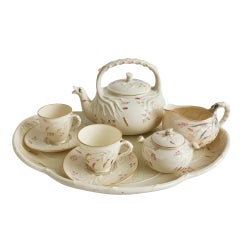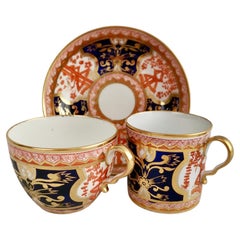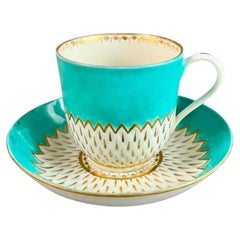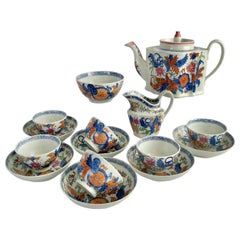Want more images or videos?
Request additional images or videos from the seller
1 of 12
Belleek Small Porcelain Mug, Cream and Green Shamrock Pattern, 1926-1946
Price:$175
About the Item
- Creator:Belleek Pottery Ltd. (Maker)
- Dimensions:Height: 2.6 in (6.61 cm)Width: 3.75 in (9.53 cm)Depth: 2.75 in (6.99 cm)
- Style:Arts and Crafts (In the Style Of)
- Materials and Techniques:
- Place of Origin:
- Period:
- Date of Manufacture:1926-1946
- Condition:Wear consistent with age and use. The set is in perfect antique condition without any damage, repairs, crazing or wear.
- Seller Location:London, GB
- Reference Number:Seller: A-BEL10h1stDibs: LU4805128780622
About the Seller
5.0
Vetted Professional Seller
Every seller passes strict standards for authenticity and reliability
Established in 2016
1stDibs seller since 2019
227 sales on 1stDibs
Typical response time: 1 hour
Authenticity Guarantee
In the unlikely event there’s an issue with an item’s authenticity, contact us within 1 year for a full refund. DetailsMoney-Back Guarantee
If your item is not as described, is damaged in transit, or does not arrive, contact us within 7 days for a full refund. Details24-Hour Cancellation
You have a 24-hour grace period in which to reconsider your purchase, with no questions asked.Vetted Professional Sellers
Our world-class sellers must adhere to strict standards for service and quality, maintaining the integrity of our listings.Price-Match Guarantee
If you find that a seller listed the same item for a lower price elsewhere, we’ll match it.Trusted Global Delivery
Our best-in-class carrier network provides specialized shipping options worldwide, including custom delivery.You May Also Like
Contemporary Set of 2 Chubby Mugs Hand Painted Porcelain Green Pink Gold
By Coralla Maiuri
Located in Roma, RM
“I have been creating artworks and installations for a long time. Then over the past several years, pottery has absorbed most of my expressive energy. I follow an empirical, yet intu...
Category
2010s Italian Porcelain
Materials
Porcelain
$240 Sale Price / set
20% Off
H 3.35 in W 4.93 in D 3.15 in
Beautiful Limoges Porcelain Mug by Jean Pouyat
By Jean Pouyat
Located in Saint-Ouen, FR
"Beautiful Limoges Porcelain mug by Jean Pouyat"
Beautiful Limoges porcelain cup, by Jean Pouyat, Napoleon III period, XIXth Century
Measures: D: 1...
Category
Antique 19th Century French Napoleon III Porcelain
Materials
Porcelain
Set of 6 Vintage Mugs with Colourful Circle Pattern, 1970s
Located in Praha, CZ
Set of six colourful mugs with circle pattern. Glazed ceramic mugs made in Poland by Lubiana in the 1970s.
Category
Mid-20th Century Polish Mid-Century Modern Porcelain
Materials
Porcelain
$284 Sale Price / set
20% Off
H 3.55 in Dm 3.15 in
Swansea Welsh Porcelain Kingfisher Pattern Cabinet Trio
By Swansea Porcelain
Located in Bishop's Stortford, Hertfordshire
A fine antique Welsh porcelain cabinet trio decorated in the Kingfisher pattern by sought after maker Swansea and dating from around 1820. The trio comprises of a teacup, a coffee cu...
Category
Antique 1820s Welsh George III Tea Sets
Materials
Porcelain
Antique Fine Irish Belleek Porcelain Demitasse Cup and Saucer
By Belleek Pottery Ltd.
Located in Chula Vista, CA
Fine Irish Belleek Demitasse Cup and Saucer
basketweave shamrock eggshell antique porcelain
Saucer 4.5 Cup 2.5 x 2h
maker stamp present
hand painted
original estate preowned vintage ...
Category
Mid-20th Century Northern Irish Mid-Century Modern Porcelain
Materials
Porcelain
KPM, Berlin, Royal Ivory Tea Service in Cream-Colored Porcelain
Located in København, Copenhagen
KPM, Berlin. Royal Ivory tea service in cream-colored porcelain with gold decoration for six people.
1920s.
Consisting of six teacups with saucers, six ...
Category
Vintage 1920s German Porcelain
Materials
Porcelain
$720 Sale Price / set
20% Off
H 2.37 in Dm 4.34 in
Belleek - 'Neptune' - Ceramic Cream Jug - Ireland - circa 1965-1980
By Belleek Pottery Ltd.
Located in Chatham, ON
BELLEEK (Manufacturer) - ' Neptune ' (Pattern) - Vintage porcelain cream jug - large Size - featuring a yellow iridescent glaze to the handle - green maker's mark to the bottom - Ire...
Category
Mid-20th Century Irish Victorian Porcelain
Materials
Porcelain
$416 Sale Price
30% Off
H 4 in W 5.25 in D 3.88 in
Kpm, Berlin, Five Royal Ivory Teacups with Saucers in Cream-Colored Porcelain
Located in København, Copenhagen
KPM, Berlin. Five Royal Ivory teacups with saucers in cream-colored porcelain with gold decoration.
1920s.
The cup measures: 11 x 7 cm.
Saucer diameter: 16.5 cm.
In excellent con...
Category
Vintage 1920s German Porcelain
Materials
Porcelain
$400 Sale Price / set
20% Off
H 2.37 in Dm 4.34 in
KPM, Berlin, Seven Royal Ivory Tea Cups with Saucers in Cream-Colored Porcelain
Located in København, Copenhagen
KPM, Berlin. Seven Royal Ivory tea cups with saucers in cream-colored porcelain with gold decoration. 1920s.
The cup measures: 9.3 x 5.5 cm.
Sauc...
Category
Vintage 1920s German Porcelain
Materials
Porcelain
$480 Sale Price / set
20% Off
H 1.97 in Dm 3.55 in
KPM, Berlin, Six Royal Ivory Tea Cups with Saucers in Cream-Colored Porcelain
Located in København, Copenhagen
KPM, Berlin. Six Royal Ivory tea cups with saucers in cream-colored porcelain with gold decoration. 1920s.
The cup measures: 9.3 x 5.5 cm.
Sauce...
Category
Vintage 1920s German Porcelain
Materials
Porcelain
$416 Sale Price / set
20% Off
H 1.97 in Dm 3.55 in
More From This Seller
View AllBelleek Cabaret Tea Set for Two, Cream Grass Pattern, Victorian 1863-1891
By Belleek Pottery Ltd.
Located in London, GB
This is a beautiful and very rare Belleek cabaret set in the Grass design, consisting of a teapot, two teacups and saucers, a milk jug and a lidded sugar bowl, all placed on a large tray. All items carry the 1st Black Mark, which was used between 1863 and 1891.
It is extremely rare to come across an entire cabaret set of these antique items, particularly when in such fabulous condition, so this is a rare opportunity!
If you ever thought Belleek fine china looks, sounds and feels unique, you are right. There is a back story to this extraordinarily fine Irish eggshell porcelain, which has an unusually high amount of "frit" and therefore is thinner and finer than any other china.
Pottery in Belleek (in the now Northern-Irish area of Fermanagh) had started in 1849 with John Caldwell Bloomfield, who was a wealthy land owner. During the Irish famine...
Category
Antique Late 19th Century Northern Irish Victorian Tea Sets
Materials
Porcelain
Spode Porcelain Teacup Trio, Red Imari Dollar Pattern, Regency, ca 1810
By Spode
Located in London, GB
This is a beautiful orphaned teacup made by Spode in about 1810. It bears a lavish Japanese-inspired Imari pattern.
Spode was the great pioneer among the Georgian potters in England. Around the year 1800 he perfected the bone china recipe that has been used by British potters ever since, and he was also the leading potter behind the technique of transferware, making it possible for English potters to replace the Chinese export china, which had come to an end around that time, with their own designs. This was fundamental to a thriving industry that would last for about 150 years and provide half the world with their tableware. Spode porcelain is regarded as one of the highest quality porcelains around; for a soft-paste porcelain it is surprisingly hard and fine, and has a wonderful bright white colour.
The pattern on this can is called "Dollar" pattern, a very famous pattern that was used by English potters in the 18th and early 19th Century. It is obvious why it is called “dollar” - but its origin is less obvious! It is thought that this pattern was derived from a very old Chinese pattern depicting a tree with elaborate foliage that hides a Chinese character representing longevity or happiness. Traditionally, this went with a an image called “Taotie”, which was used on very ancient bronze vases...
Category
Antique Early 1800s English Regency Porcelain
Materials
Porcelain
Derby Porcelain Coffee Cup, Artichoke Pattern in Turquoise, Georgian ca 1785
By Derby
Located in London, GB
This is a beautiful coffee cup and saucer made by Derby in about 1785. The set has the distinctive "artichoke" moulding and a bright turquoise ground with the white artichoke surface...
Category
Antique 1780s English George III Tea Sets
Materials
Porcelain
New Hall Porcelain Tea Service, Japanese Tobacco Pattern, Georgian, circa 1795
By New Hall
Located in London, GB
This is a stunning tea service made by New Hall in circa 1795. The service is made of hybrid hard paste porcelain and decorated in a bold Chinoiserie pattern of large flower sprays. The service consists of a teapot with cover, a milk jug, a slop bowl, and six tea bowls with saucers.
This service has provenance; it came from the collection of David Redstone, the well known porcelain expert who wrote leading books on Bow and Chelsea porcelain.
The New Hall factory started as a cooperative of several Staffordshire potters making use of the porcelain license of Bristol Porcelain...
Category
Antique 1790s English George III Tea Sets
Materials
Porcelain
$2,900 / set
Free Shipping
Samuel Alcock Porcelain Teapot, Blue, Gilt and Flowers, Rococo Revival ca 1837
By Samuel Alcock & Co.
Located in London, GB
A teapot with cover in the “rustic bean” shape, cobalt blue ground with gilt acanthus motif and finely painted flower posies on the belly of the teapot
Pattern 5782
Year: ca 1837
Si...
Category
Antique 1830s English Rococo Revival Tea Sets
Materials
Porcelain
Samuel Alcock Porcelain Teacup, White with Flower Sprays, ca 1823
By Samuel Alcock & Co.
Located in London, GB
A teacup and saucer in the “half orange” shape, white with simple gilt rim and beautiful hand painted flower sprays
Pattern unknown but similar to 1082
Year: ca 1823
Size: cup diameter 10cm (4”), saucer diameter 14.2cm (5.5”)
Condition: excellent, some rubbing to gilt
There are several items available in this design, please see group image and ask for more info if interested.
The Samuel Alcock factory was operative in Staffordshire between 1822 and 1856, after which it was bought by Sir James Duke and Nephews. The factory started as a partnership between the young Samuel Alcock and the older Ralph Stevenson, who provided the factory and capital. Alcock quickly took the factory to great heights, building one of the biggest factories of its time. Alcock jumped on the new Rococo Revival fashion and served a huge new middle class market. The reason we now don't hear much about Samuel Alcock porcelain...
Category
Antique 1820s English Regency Tea Sets
Materials
Porcelain
Recently Viewed
View AllMore Ways To Browse
Antique Eggshell Porcelain
Green And Cream Pottery
Irish Shamrock
Antique Belleek Pottery Ireland
Belleek Hand Painted
Irish Silver Tea Set
Irish Tea Set
Belleek China
Belleek Tea Set
Shamrock Belleek
Gold Teapot
Imari Tea Set
Victorian Teapot
Antique Chocolate Pots
Danish Teapot
England Tea Pots
Silver Tea Set London
Teapot Flowers



